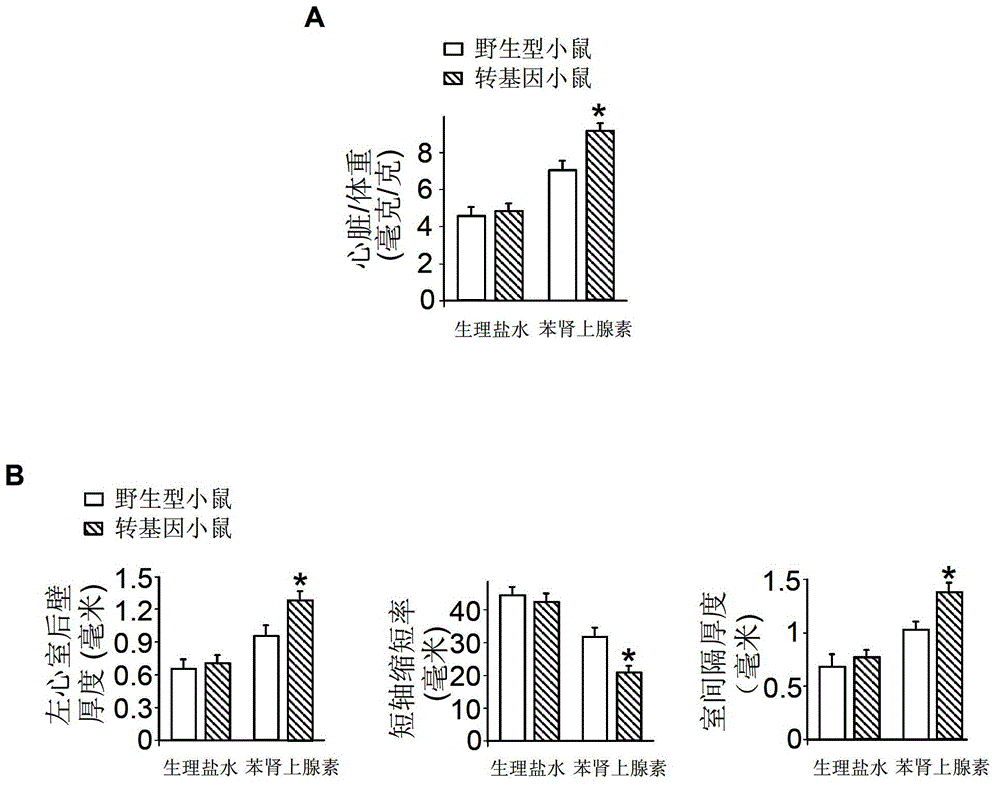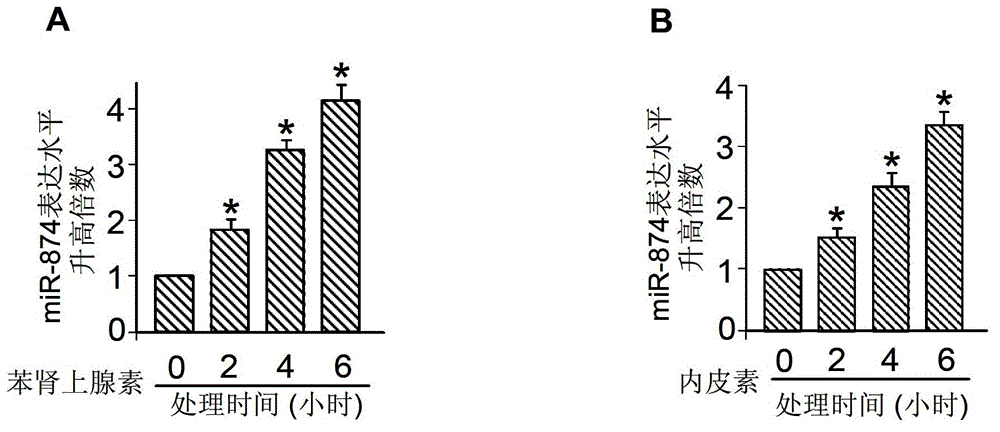MiRNA (micro ribose nucleic acid)-874 and application of miRNA-874antisense nucleotide
A technology of miRNA-874 and antisense nucleotides, which can be used in medical preparations containing active ingredients, gene therapy, cardiovascular system diseases, etc., and can solve the problem of unidentified key miRNAs
- Summary
- Abstract
- Description
- Claims
- Application Information
AI Technical Summary
Problems solved by technology
Method used
Image
Examples
Embodiment 1
[0040] Example 1 The heart weight ratio and cardiac function of miRNA-874 transgenic mice are comparable to those of wild type no significant change than
[0041] Heart weight ratio analysis was performed on the hearts of miRNA-874 transgenic mice and wild-type mice, and the number of samples for each of the two groups of mice was 26. Experimental results such as figure 1 A shows that miRNA-874 transgenic mice have no significant increase in heart weight ratio compared with wild-type mice, indicating that miRNA-874 transgenic mice themselves have no obvious changes in hypertrophic phenotype.
[0042] The indicators of cardiac function detected at the same time include left ventricular posterior wall thickness (LVPWd) and fractional shortening (FS). Such as figure 1 As shown in B, the experimental results showed no significant difference in heart function between miRNA-874 transgenic mice and wild-type mice.
experiment example 2
[0043] Experimental Example 2 miRNA-874 transgenic mice were stimulated with PE (phenylephrine) and wild Heart weight ratio and heart function have been significantly changed compared with raw mice
[0044] The hearts of miRNA-874 transgenic mice and wild-type mice were injected with hypertrophy-stimulating factor PE. Among them, 6 miRNA-874 transgenic mice and 6 wild-type mice were used, and the dosage of PE was 75mg / kg / day. The control groups were miRNA-874 transgenic mice and wild-type mice treated with saline instead of PE. Heart-to-weight ratio analysis was performed after two weeks, see figure 2 A in Experimental results such as figure 2 As shown in A, the heart weight ratio of miRNA-874 transgenic mice after PE treatment was significantly increased compared with the control group, indicating that miRNA-874 transgenic mice after PE treatment had obvious hypertrophic phenotype changes .
[0045] The detection of cardiac function includes LVPWd (left ventricula...
experiment example 3
[0046] Experimental example 3 Changes in the expression level of miRNA-874 under the stimulation of PE and endothelin (ET-1) change
[0047] For the hypertrophy model of cardiomyocytes, adopt the method established in our laboratory to culture the primary cardiomyocytes of rat suckling rats, and treat the cardiomyocytes with PE and ET-1 (the dosage of PE is 50μM; the dosage of ET-1 is 100nM) , at different times in culture, extract the total RNA of the cells, and use real-time fluorescent quantitative PCR technology to detect (see the following literature: W.-Q.Tan, Kun Wang, et al., Foxo3a Inhibits Cardiomyocyte Hypertrophy through Transactivating Catalase.J Biol Chem.2008 October 31;283(44):29730-29739)
[0048] Specifically, the gene sequence of miRNA-874 was amplified by PCR
[0049] (TTAGCCCTGCGGCCCCACGCACCAGGGTAAGAGAGACTCGCTTCCTGCCCTGGCCCGAGG, SEQ ID NO: 3) and its upstream and downstream sequences of nearly 200 bp each, the amplified fragment is about 476bp, specif...
PUM
 Login to View More
Login to View More Abstract
Description
Claims
Application Information
 Login to View More
Login to View More - R&D
- Intellectual Property
- Life Sciences
- Materials
- Tech Scout
- Unparalleled Data Quality
- Higher Quality Content
- 60% Fewer Hallucinations
Browse by: Latest US Patents, China's latest patents, Technical Efficacy Thesaurus, Application Domain, Technology Topic, Popular Technical Reports.
© 2025 PatSnap. All rights reserved.Legal|Privacy policy|Modern Slavery Act Transparency Statement|Sitemap|About US| Contact US: help@patsnap.com



